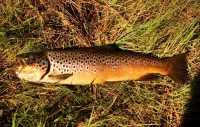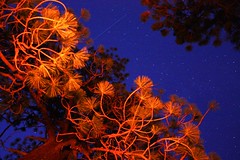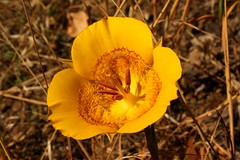
A clump of young mugwort or “molush” in the Barbareno Chumash dialect.
Plant Profile
Mugwort (Artemisia douglasiana) is a perennial herb commonly found in areas of riparian habitat.
It likes sunny, moist locations around creeks and rivers, but can also be found in areas of bright shade and the dappled light of oak and sycamore glens.
Mugwort is a member of the sunflower family and it grows in tall, straight single stems topping out at various heights up to three feet or more.
It bears multipronged lanceolate leaves that radiate outward from the main stalk in spiral formation. The leaves are green on top with a whitish colored underside, and they have a distinct herbal fragrance when crushed or rubbed that is similar to sage.
Mugwort typically grows in bushy clumps and can look like a shrub, but it is also found in stands of widely spaced individual plants.
Traditional Knowledge
Historically, Native Americans used mugwort medicinally in many ways and for a wide variety of ailments. To treat itchy skin the Pomo, Kashaya bathed the skin in mugwort tea. Locally, the Chumash used mugwort to soothe the rash caused by poison oak. In Chumash Ethnobotany, Jan Timbrook notes that the sources of ethnographer John P. Harrington (b.1884 d.1961) told of two ways mugwort was used for this purpose.
The simplest method was to grind some fresh mugwort leaves between the hands and then rub the resulting crushed wad of plant matter on the rash. Another way was to boil fresh leaves and make a tea, which was then applied to the affected area.
I was taught how to use mugwort as a kid, but to actually prevent getting poison oak rather than to treat an existing rash. I would pick the fresh leaves and crush them together and then rub them on my skin soon after exposure to poison oak. It’s a natural treatment that is free and easy to use and, I believe, always worked to somehow neutralize the active ingredient in poison oak, urushiol. And mugwort is readily available in the woods often times actually growing near or right beside poison oak.
 United States Department of Agriculture Database: Profile page for Mugwort.
United States Department of Agriculture Database: Profile page for Mugwort.
Bibliography
Jan Timbrook, Chumash Ethnobotanty: Plant Knowledge Among the Chumash People of Southern California (Santa Barbara Museum of Natural History 2007), 38.
Jennie Goodrich and Claudia Lawson, Kashaya Pomo Plants (American Indian Studies Center, University of California, Los Angeles 1980 ), 119.




































Many thanks for your post – my last bout of poison oak was nightmarish and I had no idea there was a natural Rx.
I very much enjoy your blog and look forward to your photography.
Hi Judy. Thanks for stopping by.
Glad I found this very useful information. Thank you!
Tea from white oak bark is also helpful in treating poison oak.
poison oak is a allergy and can be Removed by a Desensitized Treatment by Dr. Swink, Goleta.
How nice would it be to hike thru the brush and not worry about Poison Oak
Why pay for a doctor when all ya gotta do is rub some leaves on ya? I learned about this as a kid, also, I wasn’t allergic to it, but used it on friends that were, I’m my own eye witness, Personally, only used the leaves sometimes boiled the the leaves down to an almost tar color, then put it on the affected area, almost immediate itch relef, n dried up in a day, sometimes less, and, sometimes more.
Maybe it’s not very organic but I carry a very small shampoo bottle with joy dish soap in it while hiking the back country. If I somehow don’t see the poison oak in time and it swats me in the face I stop and wash with joy and water. At home I repeat at shower time and I think it breaks down the oil in poison oak. If you ever heard soap plant is good soap, well that’s a story in itself. Bruce
If ‘Joy’ cuts the oil in poison oak, then what about ‘Dawn’ which is the better grease cutter ? interesting.
Washing your poison oak/ivy exposed skin is effective. I believe the poison oil is water soluble.
I make a soap with mugwort, earth friendly dish soap and baking soda. it works great.
Hunh. Never heard of that. Neat.
I grew up in Santa Barbara and was taught to rub mugwort all over to prevent poison oak too. I was excited to discover your page today. Can’t wait to explore your blog more! Your page feels like home to me since I have been living elsewhere for the last 25 years.
Hey Jack!! I discovered your page today when researching mugwort, I too, like Michelle, spent some years in Santa Barbara (1972-1980) and did lots of hiking. Always used mugwort on the trail right near the poison oak and it prevented a rash. But more important, your observations on Santa Barbara capture my feelings for that beautiful, wonderful place. Lucky you!
I have found out that if I rinse with water and regular soap within 30 minutes of contact with poison Ivy I do not suffer any reaction. If I do get a reaction, often on my arms, I let water, as hot as I can stand it run over the inflammation and after maybe 4-5 minutes of this treatment the rash has stopped. Thanks for the information about mugwort, I am also surrounded by jewel weed later in the summer which I believe serves the same purpose.
If there is no mugwort nearby when you’ve accidentally contacted poison oak, try my method: Scrub the contaminated area with clean dirt.
“Clean dirt” means it has no poison oak roots in it.
Moist dirt will also take out scorpion stings. You know how some people attract mosquitos? I used to attract scorpions like that. They’d run out from under a rock ten feet away to come sting me. Hurt like stepping on broken glass for three days after, until I discovered that moist earth will remove the poison. Have to scrub about five minutes. Use “clean dirt”.